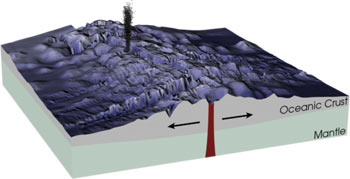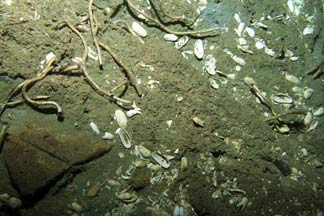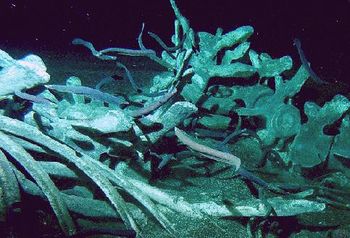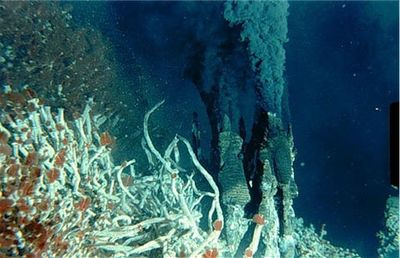Difference between revisions of "Deep sea bottom"
Dronkers J (talk | contribs) |
Dronkers J (talk | contribs) |
||
| Line 1: | Line 1: | ||
| + | |||
This article describes the habitat of the deep sea bottom. It is one of the sub-categories within the section dealing with biodiversity of [[marine habitats and ecosystems]]. | This article describes the habitat of the deep sea bottom. It is one of the sub-categories within the section dealing with biodiversity of [[marine habitats and ecosystems]]. | ||
| Line 4: | Line 5: | ||
==Deep sea bottom== | ==Deep sea bottom== | ||
| − | The bottom of the deep sea has several features that | + | The bottom of the deep sea has several features that contribute to the diversity of this habitat. The main features are mid-oceanic ridges, hydrothermal vents, mud volcanoes, seamounts, canyons and cold seeps. Carcasses of large animals also contribute to habitat diversity. |
| − | |||
===Mid-oceanic ridges=== | ===Mid-oceanic ridges=== | ||
| − | [[image:Mid-oceanic ridges.jpg|left|thumb|400px|Caption|Mid-oceanic ridge <ref name=W>http://en.wikipedia.org/wiki/Mid-oceanic_ridge</ref>]] | + | [[image:Mid-oceanic ridges.jpg|left|thumb|400px|Caption|Fig. 1. Mid-oceanic ridge with black smoker. <ref name=W>http://en.wikipedia.org/wiki/Mid-oceanic_ridge</ref>]] |
| − | |||
| − | |||
| − | |||
| + | A mid-oceanic ridge (Fig. 1) is a submarine mountain range formed by plate tectonics. It is a characteristic of the boundary between two diverging tectonic plates. The ridge results from convection currents which rise in the mantle as magma and emerge as lava, creating the new crust upon cooling. The mid-oceanic ridges are connected and form a single global mid-oceanic ridge system that is part of every ocean. It can be occupied by a rift valley that is formed by geological forces that pulled apart and broke the solid rock - a process called faulting. Mid-ocean ridges are active features characterized by frequent, shallow earthquakes, many faults and widespread volcanism. It is also segmented by transform faults, where fractured rocks slide past one another. This causes a zigzag pattern. At many places, hydrothermal vents and cold seeps are situated on these mid-oceanic ridges. <ref name=W></ref> | ||
| + | <br clear=all> | ||
===Hydrothermal vents=== | ===Hydrothermal vents=== | ||
| − | [[image:Deep sea vent.jpg|left|thumb|400px|Caption|Hydrothermal vents - Black smokers.]] | + | [[image:Deep sea vent.jpg|left|thumb|400px|Caption|Fig. 2. Hydrothermal vents - Black smokers.]] |
| − | |||
| − | |||
| − | |||
| − | |||
| − | + | Due to the use of submersibles and acoustic mapping, unique and often diverse communities have been found on features such as hydrothermal vents (Fig. 2). These vents are islands in a sea of [[mud]]. The hydrothermal vents are associated with parts of the ocean floor that exhibit high levels of tectonic activity such as mid-oceanic ridges. In these regions, hot magma chambers below the seabed heat up water that has permeated into the ocean floor. Water that seeps into cracks of the crust first loses minerals (oxygen, potassium, magnesium, ..) but is later charged with new chemicals (copper, zinc, iron, hydrogen sulfide, ..) when the highest temperatures (350-400°C) are reached. The 'smoke' is formed by black metal-sulfide minerals when the hot fluid rises up and is released in the cold, oxygen-rich seawater. <ref>http://www.divediscover.whoi.edu/vents/vent-chemistry.html</ref> This type of very hot hydrothermal vents is called a black smoker. Cooler vents also exist; they are called white smokers. | |
| − | + | A huge biomass of associated organisms thrive near the hydrothermal vents. Because of the extreme conditions and the absence of sunlight, the organisms need an adapted method of food supply. The autochthonous production of organic material is related to the supply of reduced compounds from the vents. Primary production is generated through chemosynthesis by microbial populations consisting of bacteria and archaea. They can tolerate extremely high temperatures (called hyperthermophiles (80-115°C) and superthermophiles (>115°C)). The bacteria of the vents oxidize hydrogen sulfide, add carbon dioxide and oxygen, and produce sugar, sulfur, and water. Other bacteria make organic matter by reducing sulfide or by oxidizing methane. The bacteria are prey to larger organisms, the primary consumers<ref>Kaiser M. et al. 2005. Marine ecology: Processes, systems and impacts. Oxford University Press. p.584</ref> | |
| − | |||
| − | < | ||
| Line 34: | Line 27: | ||
A [[mud]] volcano or mud dome is used to refer to formations created by geo-excreting fluids and gasses. The most abundant gas that is released is methane. | A [[mud]] volcano or mud dome is used to refer to formations created by geo-excreting fluids and gasses. The most abundant gas that is released is methane. | ||
| − | [[Seamount|Seamounts]] are mountains rising from the ocean floor | + | [[Seamount|Seamounts]] are mountains rising more than 1000 m from the ocean floor without reaching the water’s surface. They are typically formed from extinct volcanoes, which rise abruptly. It is estimated that there are more than 30,000 seamounts in the ocean (Fig. 3), but only few have been studied. They are hotspots of marine life. They can generate localized eddies and upwelling zones. Knolls are submarine hills several hundred meters high. |
| − | [[image: | + | [[image:SeamountsGlobalMap.png|center|thumb|600px|Caption|Fig. 3. Distribution of seamounts and knolls. From Yesson et al. (2011<ref>Yesson, C., Clark, M.R., Taylor, M. and Rogers, A.D. 2011. The global distribution of seamounts based on 30-second bathymetry data. Deep Sea Research Part I: Oceanographic Research Papers 58: 442-453. DOI: http://dx.doi.org/10.1016/j.dsr.2011.02.004. </ref>). Creative Commons Licence.]] |
===Cold seeps=== | ===Cold seeps=== | ||
| − | Cold seeps are found | + | Cold seeps (Fig. 4) occur over fissures on the seafloor caused by tectonic activity and are found along active and passive continental margins. They are related to geological processes such as tectonically induced high-fluid pressures, petroleum or natural gas escape, catastrophic erosion and slides. Methane-rich fluids of thermogenic and/or biogenic origin are a major source of energy. Methanotrophic bacteria use methane to produce carbonates by methane reduction. The carbonates can react with calcium to form calcium carbonate. Production of sulfide by sulfate reduction provides another energy source. Sulfate reducing bacteria use sulfate to form sulfides and this sulfide is oxidized by sulfur oxidizing bacteria that release sulfate again into the seawater. Macro-invertebrates such as mussels and tubeworms thrive on these chemosynthetic microorganisms. |
| − | |||
| − | |||
| − | |||
| − | |||
| − | |||
| − | [[image:Cold seep.jpg|thumb|center|400px|Caption|Cold seep with tube worms and bivalves <ref name=NOAA>Photo credit NOAA</ref>]] | + | [[image:Cold seep.jpg|thumb|center|400px|Caption|Fig. 4.Cold seep with tube worms and bivalves <ref name=NOAA>Photo credit NOAA</ref>]] |
===Carcasses=== | ===Carcasses=== | ||
| − | + | Carcasses of large animals from the overlying water column sink to the bottom (Fig. 5). They produce many localized food hot-spots. The carcass first sinks slowly, but as the pressure increases the carcass will gather speed. It may take many hours to reach the bottom and it may be attacked during the downward journey. When the carcass reaches the bottom, it attracts many animals. A similar food fall is the nutritious marine snow. They accumulate in tick patches separated by relatively barren areas. | |
| − | [[image:Carcass.jpg|thumb|center|350px|Caption|Whale carcass on the deep-sea bottom <ref name=NOAA></ref>]] | + | [[image:Carcass.jpg|thumb|center|350px|Caption|Fig. 5. Whale carcass on the deep-sea bottom <ref name=NOAA></ref>]] |
Latest revision as of 23:03, 24 February 2021
This article describes the habitat of the deep sea bottom. It is one of the sub-categories within the section dealing with biodiversity of marine habitats and ecosystems.
Contents
Deep sea bottom
The bottom of the deep sea has several features that contribute to the diversity of this habitat. The main features are mid-oceanic ridges, hydrothermal vents, mud volcanoes, seamounts, canyons and cold seeps. Carcasses of large animals also contribute to habitat diversity.
Mid-oceanic ridges

A mid-oceanic ridge (Fig. 1) is a submarine mountain range formed by plate tectonics. It is a characteristic of the boundary between two diverging tectonic plates. The ridge results from convection currents which rise in the mantle as magma and emerge as lava, creating the new crust upon cooling. The mid-oceanic ridges are connected and form a single global mid-oceanic ridge system that is part of every ocean. It can be occupied by a rift valley that is formed by geological forces that pulled apart and broke the solid rock - a process called faulting. Mid-ocean ridges are active features characterized by frequent, shallow earthquakes, many faults and widespread volcanism. It is also segmented by transform faults, where fractured rocks slide past one another. This causes a zigzag pattern. At many places, hydrothermal vents and cold seeps are situated on these mid-oceanic ridges. [1]
Hydrothermal vents
Due to the use of submersibles and acoustic mapping, unique and often diverse communities have been found on features such as hydrothermal vents (Fig. 2). These vents are islands in a sea of mud. The hydrothermal vents are associated with parts of the ocean floor that exhibit high levels of tectonic activity such as mid-oceanic ridges. In these regions, hot magma chambers below the seabed heat up water that has permeated into the ocean floor. Water that seeps into cracks of the crust first loses minerals (oxygen, potassium, magnesium, ..) but is later charged with new chemicals (copper, zinc, iron, hydrogen sulfide, ..) when the highest temperatures (350-400°C) are reached. The 'smoke' is formed by black metal-sulfide minerals when the hot fluid rises up and is released in the cold, oxygen-rich seawater. [2] This type of very hot hydrothermal vents is called a black smoker. Cooler vents also exist; they are called white smokers.
A huge biomass of associated organisms thrive near the hydrothermal vents. Because of the extreme conditions and the absence of sunlight, the organisms need an adapted method of food supply. The autochthonous production of organic material is related to the supply of reduced compounds from the vents. Primary production is generated through chemosynthesis by microbial populations consisting of bacteria and archaea. They can tolerate extremely high temperatures (called hyperthermophiles (80-115°C) and superthermophiles (>115°C)). The bacteria of the vents oxidize hydrogen sulfide, add carbon dioxide and oxygen, and produce sugar, sulfur, and water. Other bacteria make organic matter by reducing sulfide or by oxidizing methane. The bacteria are prey to larger organisms, the primary consumers[3]
Mud volcanoes and seamounts
A mud volcano or mud dome is used to refer to formations created by geo-excreting fluids and gasses. The most abundant gas that is released is methane. Seamounts are mountains rising more than 1000 m from the ocean floor without reaching the water’s surface. They are typically formed from extinct volcanoes, which rise abruptly. It is estimated that there are more than 30,000 seamounts in the ocean (Fig. 3), but only few have been studied. They are hotspots of marine life. They can generate localized eddies and upwelling zones. Knolls are submarine hills several hundred meters high.

Cold seeps
Cold seeps (Fig. 4) occur over fissures on the seafloor caused by tectonic activity and are found along active and passive continental margins. They are related to geological processes such as tectonically induced high-fluid pressures, petroleum or natural gas escape, catastrophic erosion and slides. Methane-rich fluids of thermogenic and/or biogenic origin are a major source of energy. Methanotrophic bacteria use methane to produce carbonates by methane reduction. The carbonates can react with calcium to form calcium carbonate. Production of sulfide by sulfate reduction provides another energy source. Sulfate reducing bacteria use sulfate to form sulfides and this sulfide is oxidized by sulfur oxidizing bacteria that release sulfate again into the seawater. Macro-invertebrates such as mussels and tubeworms thrive on these chemosynthetic microorganisms.

Carcasses
Carcasses of large animals from the overlying water column sink to the bottom (Fig. 5). They produce many localized food hot-spots. The carcass first sinks slowly, but as the pressure increases the carcass will gather speed. It may take many hours to reach the bottom and it may be attacked during the downward journey. When the carcass reaches the bottom, it attracts many animals. A similar food fall is the nutritious marine snow. They accumulate in tick patches separated by relatively barren areas.

References
- ↑ 1.0 1.1 http://en.wikipedia.org/wiki/Mid-oceanic_ridge
- ↑ http://www.divediscover.whoi.edu/vents/vent-chemistry.html
- ↑ Kaiser M. et al. 2005. Marine ecology: Processes, systems and impacts. Oxford University Press. p.584
- ↑ Yesson, C., Clark, M.R., Taylor, M. and Rogers, A.D. 2011. The global distribution of seamounts based on 30-second bathymetry data. Deep Sea Research Part I: Oceanographic Research Papers 58: 442-453. DOI: http://dx.doi.org/10.1016/j.dsr.2011.02.004.
- ↑ 5.0 5.1 Photo credit NOAA
Please note that others may also have edited the contents of this article.
|
